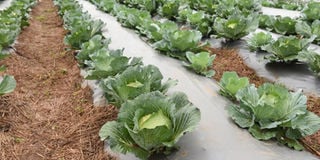Forget grass, here’s new way to mulch crops

The technology prevents the fruits and vegetables from getting into contact with the soil and reduces damage to the roots. Photo | George Katongole
What you need to know:
- With plastic mulch technology, there is firmness in the soil on a particular bed and nutrients are relayed to where they are needed. Less water is used as irrigation is targeted to the spot where it is needed.
- Further studies reveal that plastics become brittle with age and can be disked into the soil and those small pieces of plastic remain in the field for years. Since plastic mulch does not break down easily, it is feared to cause environmental challenges.
By George Katongole
Plasticulture (also known as plastic mulching) has been with us since the 1960s even though it is yet to gather steam in Uganda.
The use of agriculture films, a practice commonly known as plasticulture, has been practiced elsewhere as plans to improve crop yield and quality took centre stage.
In developed countries, huge investments are being made for biodegradable and bio-based polymer films to match the rising demand for high-quality crops.
Plastic mulching
Luckily, plastic mulching is making baby steps into Uganda’s farming practices.
The Songhai Model site in Kampiringisa, Mpigi District is investing in the technology by providing training to encourage implementation of new farm techniques. Plasticulture works with the application of plastic sheeting over the soil paired with a drip irrigation system which can be buried a few inches beneath.
Plastic mulch without drip irrigation is not recommended. Rainfall through planting holes is limited, particularly as plants begin to grow and cover the holes with stems and foliage. Lateral movement of water is also limited, especially with the barrier of plastic buried at the edges of the bed.
Samson Luwagga, an agronomist at Songhai Model site says the advantages of this form of mulching are enormous.
He says the water released by the drip system provides nourishment directly to the crops’ roots, so it is not lost to evaporation.
According to Luwagga, fertilisers can be mixed with the water in the drip system, allowing much low cost application while reducing run-off.
The plastic mulch traps water near the roots while weed seeds under the plastic mulch die for lack of sunlight.
The most important idea according to Luwagga is that when the plants start fruiting, the produce sits on top of plastic rather than being surrounded by soil.
“This increases the quality of the crop desired in export markets by cutting down on wasted produce and limiting soil-borne disease,” says Luwagga.
Choice of plastic
Luwagga explains that when a farmer decides to use plastic films, the first decision should consider the type of plastics to be used. He says embossed plastic is resistant to air damage while smooth plastic works well for flat beds although it tends to tear easily.
According to him, the standard agriculture grade film is 1.25mm. Suppliers sell these plastics between Shs7,000 and Shs15,000.
Luwagga explains that black plastic film is the most effective in absorbing heat while white, which is reflective, and desirable on reducing the impact of heat on sensitive crops.
He says white films are important for growing maize but it must be punched to prevent the crops from burning.
Luwagga adds that other colours such as red should be tested by farmers before they can be used. Richard Ssepuya, an agricultural consultant at Crop Farms Uganda in Mukono District adds that farmers should avoid the temptation of using cheap damp proof membrane liners which are used at building sites.
“It is important to look out for agriculture grade plastic mulch whose top is aluminum with a black base,” Ssepuya explains.
At his farm, he uses 100 gauge plastic film. A square metre costs Shs2,500 at retail price.
Best practices
Plasticulture is critical in vegetable production by using raised beds complemented with drip irrigation. It is used in conjunction with a raised bed as it provides for a deeper soil profile and a better drainage around the system.
It is hailed for its ability to increase both yields and quality for crops such as melons, tomatoes, green peppers, and cucumber.
If you are using plastic mulch, it is important to apply drip irrigation. Drip irrigation primarily provides water and fertilisers in a controlled manner. Large scale farmers can use tractors that can form beds. Luwagga says the soils must be properly tilled before laying the bed.
It is typically a good idea, he says, to wait for 7-10 days for the soil to warm up and settle before planting.
Shortcomings
However, plasticulture is not without problems, and the main problem is waste.
“The mulch cannot be used for ever. It has to be replaced at least every year,” he explains.
Knowledge of the sustainability of plastic mulching remains vague in terms of both an environmental and agronomic perspective. Researchers fear that adverse effects may arise from plastic additives, enhanced pesticide runoff and plastic residues likely to fragment into micro plastics but remaining chemically intact and accumulating in soil where they can successively sorb agrochemicals.
Further studies reveal that plastics become brittle with age and can be disked into the soil and those small pieces of plastic remain in the field for years. Since plastic mulch does not break down easily, it is feared to cause environmental challenges.




